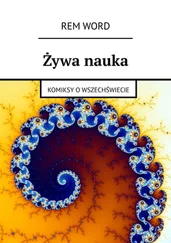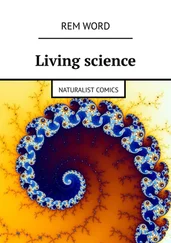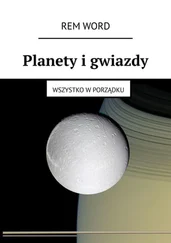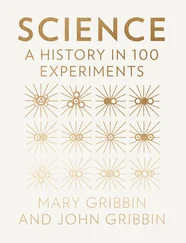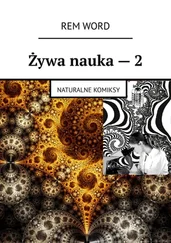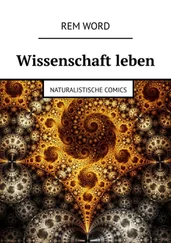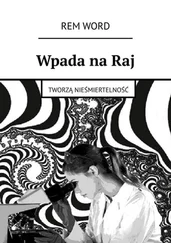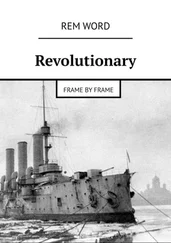Word Rem - Living Science – 3. Decisive experiment
Здесь есть возможность читать онлайн «Word Rem - Living Science – 3. Decisive experiment» — ознакомительный отрывок электронной книги совершенно бесплатно, а после прочтения отрывка купить полную версию. В некоторых случаях можно слушать аудио, скачать через торрент в формате fb2 и присутствует краткое содержание. ISBN: , Жанр: Химия, Биология, Физика, Фантастика и фэнтези, на английском языке. Описание произведения, (предисловие) а так же отзывы посетителей доступны на портале библиотеки ЛибКат.
- Название:Living Science – 3. Decisive experiment
- Автор:
- Жанр:
- Год:неизвестен
- ISBN:9785005550248
- Рейтинг книги:4 / 5. Голосов: 1
-
Избранное:Добавить в избранное
- Отзывы:
-
Ваша оценка:
- 80
- 1
- 2
- 3
- 4
- 5
Living Science – 3. Decisive experiment: краткое содержание, описание и аннотация
Предлагаем к чтению аннотацию, описание, краткое содержание или предисловие (зависит от того, что написал сам автор книги «Living Science – 3. Decisive experiment»). Если вы не нашли необходимую информацию о книге — напишите в комментариях, мы постараемся отыскать её.
Living Science – 3. Decisive experiment — читать онлайн ознакомительный отрывок
Ниже представлен текст книги, разбитый по страницам. Система сохранения места последней прочитанной страницы, позволяет с удобством читать онлайн бесплатно книгу «Living Science – 3. Decisive experiment», без необходимости каждый раз заново искать на чём Вы остановились. Поставьте закладку, и сможете в любой момент перейти на страницу, на которой закончили чтение.
Интервал:
Закладка:
Energy returns. Is always
… How to return the energy dissolved in the bustle of microparticles? Probably, there are natural processes that increase its quality to its original value. Everything happens by itself. For clarity, a boiled kettle placed on the table gives energy to the table. it cools down. High-order energy is replaced by a uniform background. Is the reverse process possible? Will heat pulses be transmitted from the medium to the kettle? Will it boil for no apparent reason, on the kitchen table? The question is strange. But this should happen if there is a circulation of energy in nature from the beginning of time. One of the first publications of the author on the topic – an article in "TM", No. 4, 2000:
…«What is the difference between an object of the macrocosm – a monolith – from a cloud of dust obtained as a result of its long grinding and subsequent shaking? It is well known: the area of contact with the medium of another phase, for example, with a gas. That is why those chemical reactions take place in powders that do not affect monoliths at all – iron filings burn in the air, while an iron nail, perhaps in pure oxygen… But the question is – what happens when a monolith is ground or, conversely, sticking together dust back into a monolith with an emission-absorption spectrum? Let’s call on the laws of quantum physics to help. In a monolith, the spectrum runs through all energy levels, which, theoretically, are as many as there are atoms in the body. In a gas, however, individual atoms radiate independently, at several levels. But when atoms-neighbors appear, the levels shift so as not to repeat each other – the exclusion principle, introduced at the beginning of the 20th century, works. Wolfgang Pauli: there can be no interconnected atoms, the energy parameters of which are the same. But powder is an intermediate state between gas and solid. Apparently, it is impossible to draw a sharp boundary at which the properties change abruptly. And accordingly, the spectrum of the dust cloud, as the particles are fragmented, will approach the spectrum of the gas. But what happens if you thicken it to the volume of the original monolith? When, say, one hundred particles merge, each energy level will take one hundred atoms at once. To restore the order accepted in the microworld, each of such oversaturated levels will tend to split into a hundred isolated lines of the spectrum. The most natural way to restore the energy hierarchy for the atoms of the newly formed monolith is to emit a certain amount of electromagnetic quanta. Consequently, the thickened cloud of dust will generally become colder than the environment.

Our magic teapot
Aren't we humans the same hubs? Why are our cells not isolated "specks of dust" separated by membranes? But the membrane permeability is constantly changing. And are not many properties of living organisms that are not amenable to modern science associated with such a combination of many millions of "dust particles"? "
Continued in the article "Energy Concentrators", "TM" No. 6, 2002, based on the materials of experiments. Two vessels, one with a porous medium, the other with a solid one, are located in a thermostat. We measure the temperature of the internal environment every 20 minutes using sensors. It turns out that the temperature in the container with the granular medium (wet sand) changes abruptly. A continuous medium produces a flat temperature graph.
Granular matter has the ability to collect energy. The temperature in the anomalies rises by tens of degrees. By organizing matter, you can achieve a predictable release of heat in certain areas of it.
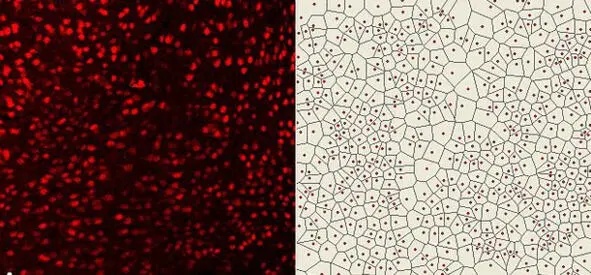
The collection and separation of dust particles of inanimate matter and the interaction of cell membranes, with the release of energy, are phenomena of the same level.
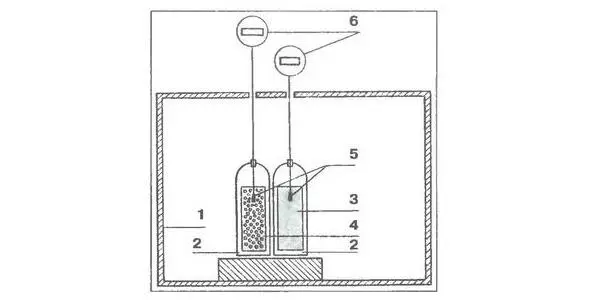
Experiment with granular and homogeneous media. 1. cabinet with thermal insulation 2. Dewar vessels 3. continuous medium (water) 4. porous medium 5. electronic thermometers. 6. temperature sensors.
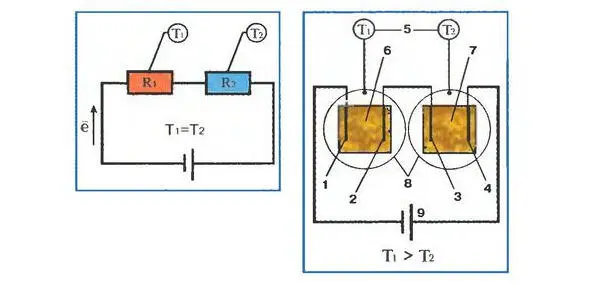
Experience with the passage of direct current through granular cells
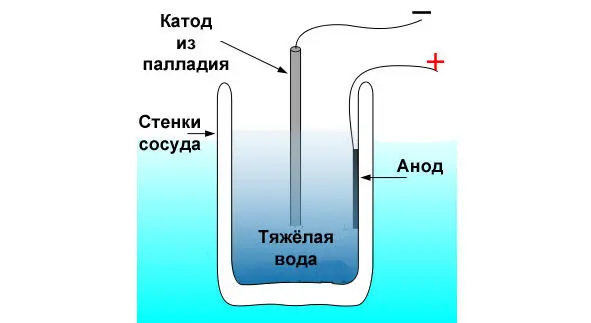
Fleischmann and Pons experience. The cathode, absorbing nuclei of hydrogen from heavy water, releases an abnormally large amount of energy
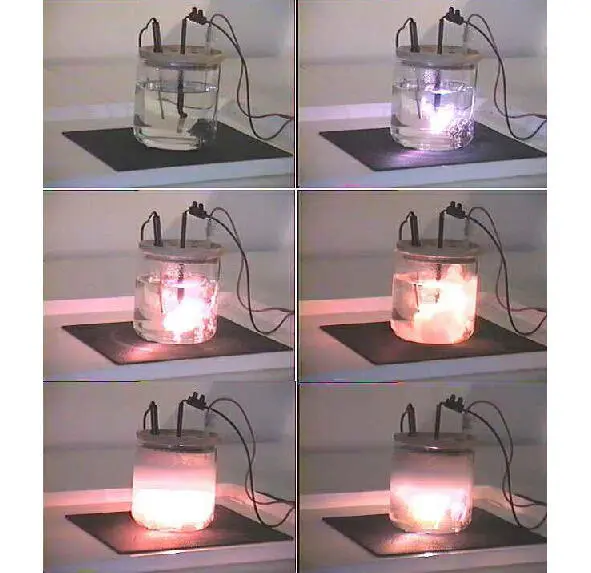
Experiments of Fleischmann and Pons in practice
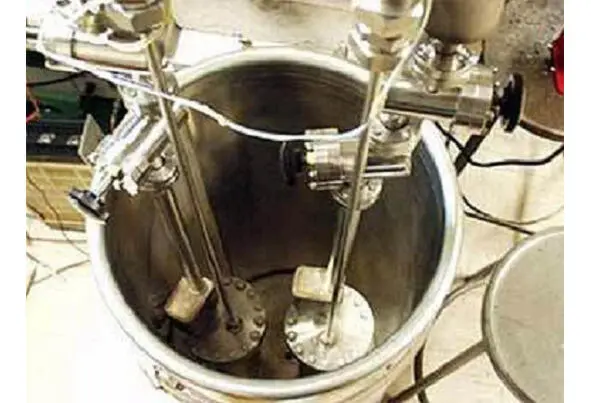
Cold fusion reactor from Japanese researchers. Osaka University. Palladium and zirconium oxide absorb deuterium. If gas bubbles also get into the mixture, the temperature of the heavy water reaches 70 degrees. Demonstration in front of reporters is successful. Scientists believe that heating is the result of nuclear fusion. However, if the water reached this temperature due to the fusion of nuclei, the radiation would kill those present.
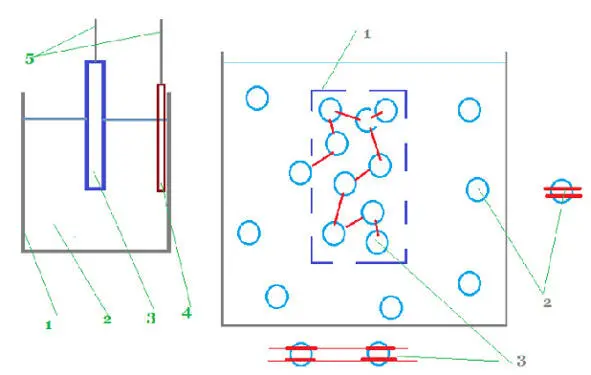
On the left is a diagram of the experiments of Fleischmann and Pons. 1.the walls of the vessel, 2.deuterium (heavy) water, 3.palladium cathode, 4.anode (positive electrode), 5.electric power supply Right. A possible explanation for the cold fusion experiments on the right. 1. Schematic representation of an electrode – a porous vessel that absorbs microparticles, 2. Water molecules outside the cathode. A pictorial image of a microparticle with two active levels is presented. 3. Water molecules having the same levels react and generate a cascade of resonant quanta. Heat is released without nuclear fusion. Heavy water can be replaced with tap water. Palladium is replaceable with any granular media. A variant of the addition to the reactor is the adjacent mirror plates of the resonator.

Presumably, knowing the peculiarities of the circulation of energy in nature, you can cook a lot of porridge
What is a «granular medium»? As a first approximation, this is sand soaked in water. The second article on the topic, the journal «Tekhnika-Molodezhi», No. 6, 2003.
«Some fundamental laws of physics are so simple and obvious that no one doubts their validity and no one is engaged in their verification. In particular, this concerns Ohm’s law, according to which the strength of the direct current in the circuit (at least with its low density) is equal to the quotient of dividing the voltage by the resistance: I = U / R. Other electrical engineering rules follow from this. For example, according to the Joule-Lenz law, the heat W generated at the resistance R is directly proportional to the voltage drop U across it, the current I and the duration of its passage t, that is, W = R-U-1-t. Therefore, if two identical resistances are connected in series in a closed circuit, then the same amount of heat should be released on them per unit of time. It seems quite obvious that, bypassing the first resistance, electrons are not able to either acquire additional energy or lose it. But is Ohm’s law really fulfilled for resistances of all kinds at low current densities? Having become interested in this issue, I performed a series of simple experiments. I connected two, if possible, identical resistances to the DC circuit, and next to them I attached sensors of sensitive thermometers. Each resistance together with its „own“ sensor was placed in a separate thermostat. In the first experiments, I used incandescent lamps (rated for a voltage of 2.5 V and a current of 0.15 A) as resistances. Turning on the current (its source was a stabilizing step-down transformer and a rectifier connected to a household circuit with a voltage of 220 V), I measured the temperature in thermostats for an hour; then swapped lamps and repeated measurements. Five series of similar experiments showed that metal resistances emitted an amount of heat in full accordance with the classical laws of electrical engineering, regardless of where these resistances were located. I did not carry out measurements using other types of resistances, but I performed the experiment using electrolytic cells as resistance, in which ordinary tap water decomposed on stainless steel electrodes. The result, again, did not reveal any anomalies. But if the electrolysis of water was carried out in a porous, inhomogeneous medium, the picture turned out to be different. I filled the electrolytic cells with a mixture of quartz sand and tap water, acidified for better electrical conductivity with a few drops of hydrochloric acid (which, generally speaking, is not necessary). And the very first experiments gave amazing results that did not correspond to the classical laws of electrical engineering. Namely, the temperature in the thermostat located in the direction of the electrons’ movement turned out to be significantly higher than the temperature in the next thermostat! With a voltage of the current source of 220 V and its strength of 0.5 A, the difference was 90C, which significantly exceeded the error value of previous experiments. In total, I performed 10 similar experiments and noticed that the temperature difference between the cells clearly depends on the current in the circuit and can even reach several tens of degrees. I also noticed that the voltage drop on the first cell was higher than on the second (150 and 70 V, respectively), which explains the increased heat generation. But the main question remained unanswered: why does such a noticeable asymmetry arise, if before and after the experiments the resistance of the cells were the same? After all, this effect should not be! It can be assumed that in the first cell the electrons lose part of some of their internal energy and therefore in the second cell are no longer able to interact with ions as intensely. But after all, the second cell also (although not a style) heats up. True, in sand-water electrolytic cells there are many local and rather sharp drops in the resistance of the medium, as a result of which the electrons in it are either sharply accelerated, then sharply slowed down. Is this the reason for the effect I observed?..»
Читать дальшеИнтервал:
Закладка:
Похожие книги на «Living Science – 3. Decisive experiment»
Представляем Вашему вниманию похожие книги на «Living Science – 3. Decisive experiment» списком для выбора. Мы отобрали схожую по названию и смыслу литературу в надежде предоставить читателям больше вариантов отыскать новые, интересные, ещё непрочитанные произведения.
Обсуждение, отзывы о книге «Living Science – 3. Decisive experiment» и просто собственные мнения читателей. Оставьте ваши комментарии, напишите, что Вы думаете о произведении, его смысле или главных героях. Укажите что конкретно понравилось, а что нет, и почему Вы так считаете.


